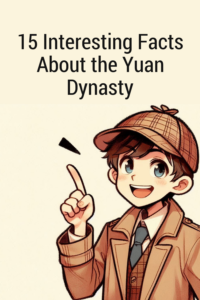Introduction:
The Tang Dynasty, considered one of the most prosperous periods in Chinese history, reigned from 618 to 907 AD. This era was known for its advancements in art, literature, science, and technology. Here are 15 interesting facts about the Tang Dynasty that will give you a deeper insight into this fascinating time in history.
Fact 1: Rise to Power
The Tang Dynasty was founded by Li Yuan, who later became Emperor Gaozu, after overthrowing the Sui Dynasty. He ruled from 618 to 626 and established the Tang Dynasty, which would go on to become one of the most powerful and influential dynasties in Chinese history.
Fact 2: Equal Rights for Women
During the Tang Dynasty, women enjoyed more rights and freedoms than in previous dynasties. They were allowed to inherit property, own businesses, and participate in politics. Some women even held positions of power in the imperial court.
Fact 3: Golden Age of Poetry
The Tang Dynasty is often referred to as the Golden Age of Chinese poetry. Many famous poets, such as Li Bai and Du Fu, emerged during this period and produced some of the most celebrated works in Chinese literature. Poetry was a highly valued art form, and poets were revered in society.
Fact 4: The Silk Road
The Tang Dynasty was a time of great prosperity and cultural exchange due to the thriving Silk Road trade route. This network of trade routes connected China to Central Asia, the Middle East, and Europe, facilitating the exchange of goods, ideas, and technologies between civilizations.
Fact 5: Technological Advancements
The Tang Dynasty was known for its technological innovations, including the invention of woodblock printing, gunpowder, and the compass. These advancements had a significant impact on Chinese society and helped to propel China to the forefront of global innovation.
Fact 6: Empress Wu Zetian
Empress Wu Zetian was the only female emperor in Chinese history, ruling during the Tang Dynasty. She was known for her intelligence, political savvy, and ruthlessness. During her reign, she implemented a series of reforms that strengthened the central government and expanded the empire’s influence.
Fact 7: Tang Dynasty Fashion
The Tang Dynasty was known for its vibrant and elaborate fashion trends. The clothing of the time featured bright colors, intricate patterns, and luxurious fabrics. Women often wore long, flowing robes with elaborate headpieces, while men favored loose-fitting tunics and trousers.
Fact 8: Wuzhou Horse
The Wuzhou Horse, also known as the Ferghana horse, was a prized breed during the Tang Dynasty. These horses were imported from Central Asia and were highly coveted for their speed, strength, and endurance. They played a crucial role in military campaigns and were a symbol of nobility and wealth.
Fact 9: Grand Canal
The Grand Canal, built during the Sui Dynasty and expanded during the Tang Dynasty, was a monumental engineering feat that connected the Yellow River and Yangtze River. This extensive waterway facilitated the transportation of goods and people across the empire, boosting economic growth and cultural exchange.
Fact 10: The An Lushan Rebellion
The An Lushan Rebellion, which took place from 755 to 763, was a devastating civil war that nearly tore the Tang Dynasty apart. The rebellion was led by the general An Lushan and resulted in the loss of millions of lives and widespread destruction. Although the rebellion was eventually crushed, it weakened the Tang Dynasty’s hold on power.
Fact 11: White Pagoda Temple
The White Pagoda Temple, also known as Bai Ta Si, is a famous Buddhist temple in Beijing that dates back to the Tang Dynasty. The temple is named after its iconic white pagoda, which stands at over 50 meters tall and is a symbol of peace and enlightenment. It is one of the oldest surviving wooden structures in China.
Fact 12: Tea Culture
The Tang Dynasty was instrumental in the development of Chinese tea culture. Tea drinking became a popular pastime among the nobility and elite, with intricate tea ceremonies and rituals evolving during this time. Tea houses sprung up across the empire, serving as social hubs for intellectuals, poets, and artists.
Fact 13: The Five Dynasties and Ten Kingdoms
Following the collapse of the Tang Dynasty in 907, China entered a period of political turmoil known as the Five Dynasties and Ten Kingdoms. This era was marked by constant warfare, shifting borders, and fragmented rule. It wasn’t until the rise of the Song Dynasty in 960 that stability was restored to China.
Fact 14: Tang Dynasty Art
Tang Dynasty art was characterized by its realism, elegance, and attention to detail. The era saw the flourishing of various art forms, including painting, sculpture, ceramics, and calligraphy. Tang artists drew inspiration from nature, mythology, and everyday life, creating intricate and vibrant works of art that continue to be admired today.
Fact 15: End of the Tang Dynasty
The Tang Dynasty came to an end in 907 after a period of decline marked by political unrest, economic hardship, and military conflicts. The last Tang emperor was overthrown by the warlord Zhu Wen, who established the Later Liang Dynasty. Despite its eventual downfall, the Tang Dynasty left a lasting legacy of cultural, technological, and artistic achievements that continue to influence Chinese society.
Conclusion
The Tang Dynasty was a remarkable period in Chinese history that witnessed unparalleled advancements in art, literature, science, and technology. From the rise of powerful rulers to the emergence of renowned poets and artists, the Tang Dynasty’s legacy continues to captivate historians and enthusiasts alike. By delving into these 15 interesting facts about the Tang Dynasty, we gain a deeper appreciation for the cultural richness and complexity of this influential era.
Subscribe to our email newsletter to get the latest posts delivered right to your email.





Comments